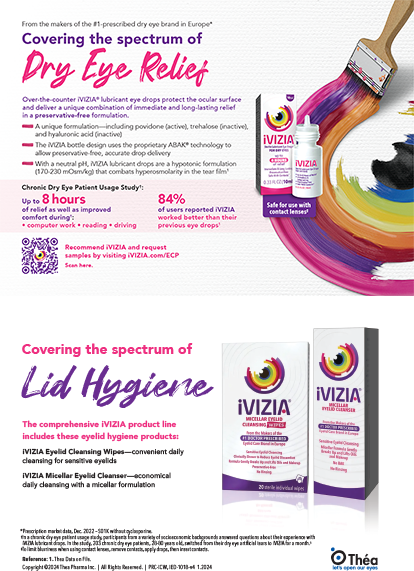At present, clear corneal incisions represent the best wound for the latest advances in cataract surgery. A temporal clear corneal incision provides easy access for cataract surgery even in the most difficult eyes with deep sockets, and it is ideal for topical-anesthetic ocular surgery.1
Traditionally, the first step in constructing a wound is choosing an available knife, either diamond or metal. Metal blades are not as sharp as diamond ones, and surgeons create less accurate and irregular incisions. Because metal blades meet more resistance from the cornea, however, they permit surgeons to gradually construct the incision with planned segments (Figure 1). Incisions made with a metal blade may be irregular, however, due to cicatrization. Diamond blades, being much sharper, produce more regular incisions faster, but the surgeon has less opportunity to change the direction of the cut if it was initially planned incorrectly. An overly short tunnel may result.1-8
We have found that the BD Atomic Edge Safety cataract slit knife (BD Ophthalmic Systems, Franklin Lakes, NJ) blends the advantages of metal and diamond blades. This knife is scheduled to be introduced to the US market in the autumn of 2007.
ABOUT THE KNIFE
The BD Atomic Edge Safety cataract slit knife is the first single-use, safety-engineered, silicon surgical knife for use in ophthalmic surgery. It allows even novice surgeons control when constructing a corneal tunnel. The hardness and sharpness of the silicon blade are between that of metal and diamond knives. Furthermore, the Atomic Edge knives have a smaller edge radius than metal blades, which is helpful for maintaining optimal control and direction when creating a corneal incision.
The knife is double beveled, which facilitates cutting while keeping the blade at the level of corneal thickness selected by the surgeon. The design thus counters the tendency of conventional metal blades to first penetrate the anterior chamber.
The special features of the Atomic Edge knives allow surgeons to use the instrument as they would a diamond knife, without having to perform traditional 3.5-mm wide, 250-?m deep pre-incisions. The blade's sharpness and manageability make it easier to cut the corneal tissue, thus avoiding the risk of creating a tunnel that is too deep or superficial. Furthermore, the material and the special shape of the blade allow the surgeon almost automatically to maintain an incision of constant depth while advancing the knife into the corneal stroma.
In addition, we have not encountered the phenomenon of whitish, opaque-scar incisions common with conventional metal knives when we use the Atomic Edge knives. Silicon blades act similarly to diamonds, and rarely do corneal scars generate halos in many of our patients postoperatively.
STUDY
We compared the tunnel's construction in 22 eyes with a 2.8-mm Atomic Edge knife (group 1) versus 22 eyes with a 2.8-mm metal knife (BD Xstar; BD Ophthalmic Systems) (group 2). No pre-incision was necessary in group 1. The corneal thickness at the site of the incision was similar in both groups. All measurements were taken using the Visante OCT (Carl Zeiss Meditec, Inc., Dublin, CA). The tunnels' lengths were 1.92 ?0.41 ?m (group 1) and 1.61 ?0.22 ?m (group 2) (P<.05). The self-sealing feature of the cut was always tested by injecting balanced salt solution through the side port incision. No suture was needed in either group. Visante OCT imaging showed that the Atomic Edge's blade produced a longer, more regular corneal tunnel than the metal blade and thus improved chamber stability and provided a self-sealing wound. The tunnel's construction as well as surgical safety thus appears to be improved by this knife (Figures 1 to 4).
CONCLUSION
In our opinion, every improvement in surgical control when creating corneal incisions increases the quality of cataract surgery. These incisions are more likely to be watertight, which may reduce the risk of endophthalmitis.
The BD Atomic Edge knife is a true single-use product designed to eliminate any risk of cross-infection and the hassle of reprocessing. Single-handed activation of a safety shield protects the surgeon, the OR staff, and the blade.
Matteo Piovella, MD, is Director of the Centro di Microchirurgia Ambulatoriale in Monza, Italy. He acknowledged no financial interest in the products or companies mentioned herein. Dr. Piovella may be reached at 39 039 389 498; piovella@piovella.com.
Fabrizio I. Camesasca, MD, is Vice-Chairman of the Department of Ophthalmology at Istituto Clinico Humanitas in Milan, Italy. He acknowledged no financial interest in the products or companies mentioned herein. Dr. Camesasca may be reached at 39 02 29529396; fabrizio.camesasca@tiscali.it.
Barbara Kusa, MD, is Consultant at the Centro Microchirurgia Ambulatoriale in Monza, Italy. She acknowledged no financial interest in the products or companies mentioned herein. Dr. Kusa may be reached at 39 039 389 498; piovella@piovella.com.


